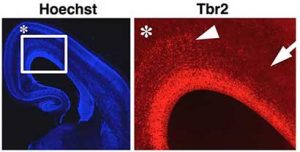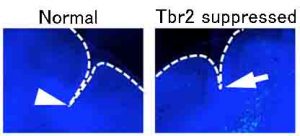Abstract:
The fold of the cerebral cortex, called the gyrus, is believed to be important in higher brain functions. In this study, the mechanism of fold formation, which used to be difficult to investigate, was elucidated by the technique developed by the present researchers, and Tbr2 gene was identified to be essential for the fold formation. It was also found that abnormality of Tbr2 caused decrease in the number of neuronal cells in the fold.
The fold of the cerebral cortex, called the gyrus, is believed to be crucial for higher brain functions. However, since the mouse, a model animal in medical research, does not form the fold of the cerebral cortex, it was difficult to investigate the fold formation. The team consisting of researchers of Kanazawa University and of a researcher of the University of Tokyo has used the ferret as a model animal; ferrets have the brain more similar to human brain than mice. Recently, the team has successfully developed a unique technique for genetic manipulation for ferrets.
In this study, by utilizing the technique developed by the present researchers, the molecular mechanism of cortical folding has been elucidated for the first time in the world. The gene essential for the folding, used to be unknown, has been identified to be Tbr2, a transcription factor, and the team has also found that abnormality of Tbr2 led to a decrease in the number of neurons of the fold. Until today, very few studies on the folding have been done by the use of animals including ferrets. Further progress of the series of this study is expected to pave the way to research on the evolution of brain up to human brain, elucidation of causes of various brain diseases, and eventually, development of their therapy.
One of the characteristics of humans is highly developed brain in comparison with that of other animals, and thanks to the development, humans have acquired special abilities. What is deeply involved in the brain development is the fold of the cerebral cortex, the gyrus, which is investigated herein.
The cerebral cortex is especially important in higher brain functions. The cerebral cortex of higher animals such as humans has a number of folds, gyri. It is considered that by developing the folds, brain is able to accommodate a large number of neurons, because of which such brains can exhibit higher brain functions. However, since the brain of mouse, a widely used model animal, has no folds, it is practically impossible to do investigations of the folding with mice. Hence, very few studies have been done on the molecular mechanisms of the folding.
The present research team has aimed at investigation of brain similar to that of humans as well as at development of research technique for ferrets, whose cerebral cortex has the fold. Thus, a research technique, a break-through, for genetic manipulation for ferrets was developed for the first time in the world. With the technique, the research team has been leading the world in generating disease model of ferret with abnormality in the folding, for example. In this study, with the aid of the technique developed as above, the mechanism of the folding of the cerebral cortex has been elucidated.
The research team has investigated the mechanism of the folding during brain development and found that Tbr2 gene is crucial for the folding. More specifically, the following four discoveries have been made.
1. Tbr2 exists in abundance where the fold would be formed.
Immunohistochemical staining of tissue sections revealed that the cerebral cortex regions that would become the fold contained more Tbr2 than the other regions. This result strongly hypothesized the importance of Tbr2 for the folding.
2. Suppression of Tbr2 function inhibited the folding.
In order to validate the hypothesis in 1), Tbr2 function in ferret brain was suppressed by the technique the research team had developed. As expected, the folding was inhibited. This result indicated that Tbr2 gene is crucial for the folding.
3. Suppression of Tbr2 function resulted in decrease of the number of neural progenitor cells.
In order to learn what happened in the cerebral cortex where folding was inhibited by the suppression of Tbr2 function, immunohistochemical staining of tissue sections was performed to reveal that the number of neural progenitor cells was reduced to a considerable extent.
4. Suppression of Tbr2 function reduced the number of neurons in the cerebral cortex.
Since suppression of Tbr2 function resulted in reduction of the number of neural progenitor cells, the number of neurons was then investigated. Immunohistochemical staining revealed reduction of neurons especially in the fold among regions of the cerebral cortex.
By summarizing these results, Tbr2 has been identified to increase the number of neural progenitor cells as well as neurons especially in the region that would become the fold among regions of the cerebral cortex. Tbr2 is therefore shown to be responsible for the folding.
In the current study, the research team elucidated the mechanism of fold formation of the cerebral cortex, by exploiting their own technique developed for ferrets. This study is a world premiere in that no such studies had been performed with animal models. The research team was also successful in making model ferret with abnormalities in folds of the cerebral cortex (2015).
Future studies are expected to contribute to the research of evolution of brain, even human brain, which was difficult with mouse models, elucidation of causes of various brain diseases, and development of their remedy.

Figure 1. A number of folds (arrows) exist on the surface of cerebral cortex.
Left: Schematic illustration of human brain, a side view.
Right: Schematic illustration of a cross section of human brain.

Figure 2. Tbr2 exists in abundance in the fold region of cerebral cortex.
Left: Construction of a tissue section of brain. Hoechst is a dye to stain the cell nucleus. The portion in rectangle marked with * will form gyrus (convex portion) at later stage of brain development.
Right: Distribution of TBR2 in the rectangle of the left part of figure, which is enlarged. The region to form gyrus marked with * is shown to contain Tbr2 in abundance (arrow head), while the region not to form gyrus does not contain much of Tbr2 (arrow).

Figure 3. Suppression of Tbr2 function leads to abnormal gyrus formation.
In the tissue section of brain, the boundary of two gyri is enlarged. The notch between two gyri (arrow) is shallower when Tbr2 is suppressed than a normal notch (arrow head). This result indicates the importance of Tbr2 in gyrus (fold) formation.

Figure 4. Summary of the present study.
Schematic illustration of cross section of cerebral cortex.
Left: Gyrus, convex part of fold, is formed from cerebral cortex region where Tbr2 is abundant.
Right:When Tbr2 function is suppressed, gyrus formation is suppressed, which indicates Tbr2 is a crucial gene for gyrus formation.
Article
Title: An essential role of SVZ progenitors in cortical folding in gyrencephalic mammals
Journal: Scientific Reports 6, Article number: 29578 (2016)
Authors: Tomohisa TODA1,2, Yohei SHINMYO1, Tung Anh Dinh DUONG1, Kosuke MASUDA1,2, Hiroshi KAWASAKI1
1Kanazawa University, 2University of Tokyo
Doi: 10.1038/srep29578
Funder
Grant-in-Aid for Scientific Research from JSPS, MEXT, and Life Science Foundation of Japan.



 PAGE TOP
PAGE TOP